
Rights, Recognition, & Respect The ESP Bill of Rights
School support staff, also known as education support professionals (ESPs), are critical to the success of our nation’s public schools. They are the bus drivers who get our students to school safely, the custodians who keep our school buildings and grounds clean, the cafeteria workers who ensure our communities are fed, the paraeducators who meet the needs of our most vulnerable students, and so much more. They are essential members of the educational team who work at every level of education—from pre-school to university graduate programs.
Despite their important roles, many ESPs have to take on more than one job to make ends meet. Nearly one-third of ESPs earn less than $25,000 a year, and on average, they are making below a living wage in all 50 states.
One job should be enough.
We're building a movement to invest in ESPs, respect their professional expertise, and recognize their vital contributions to student learning and well-being. Across the country, states are investing in ESP Bill of Rights/rESPect campaigns to build awareness and advocacy around the issues ESPs face, such as poverty-level wages, a lack of benefits, safety concerns, and lack of respect and appreciation for their contributions.
Together, we have the power to make real changes to ensure a better future for ESPs and the students they serve.
The 10 Articles of the NEA ESP Bill of Rights










The Maryland State Education Association celebrates its 500th school endorsement of the ESP Bill of Rights, explaining the difference it can make for school support staff.
Advocate for School Support Staff
Take Action Now
Looking for more ways to take action?
Share Your ESP Story
A Growing Movement
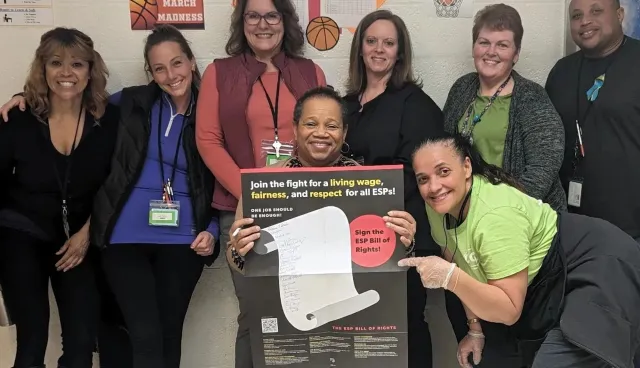
How ESPs Advocate for Fair Pay, Better Working Conditions and Respect

For School Support Staff, Respect Begins with a Living Wage

The Political Power of Education Support Professionals
Spread the Word
Use these posters, flyers, and social media graphics to get the word out about ESP rights.
Flyers & Postcards
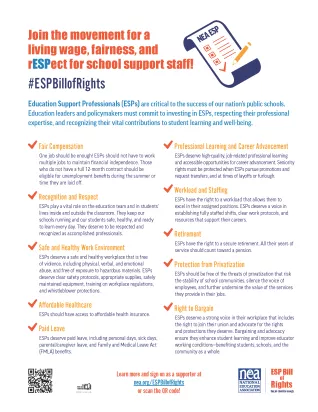

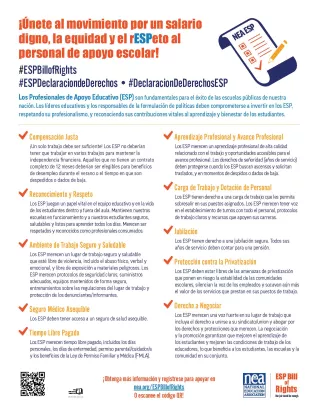

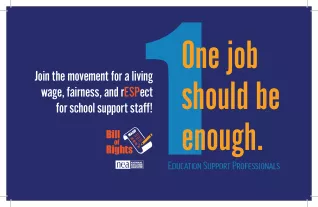

ESP Postcard Front


ESP Postcard Back




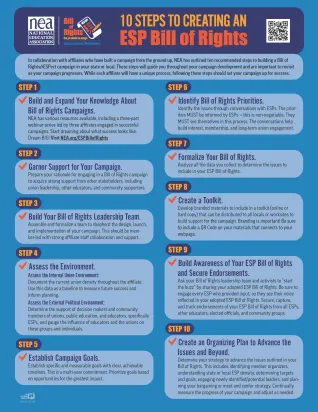

Posters & Visual Background
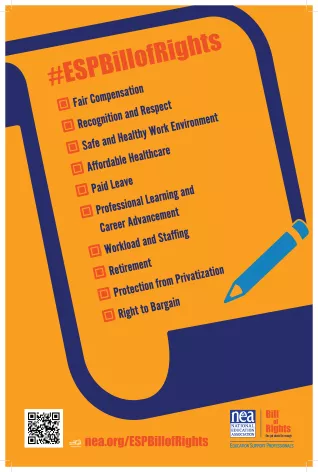





Social Media Graphics






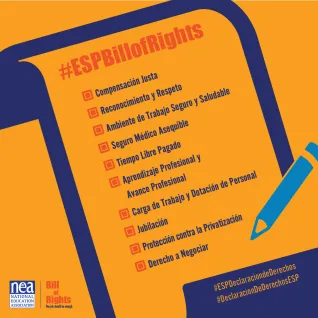

Start a Campaign
Across the country, states are investing in ESP Bill of Rights/rESPect campaigns to increase ESP visibility and secure better wages, benefits, working conditions, and more for their ESPs. These campaigns build awareness and advocacy around the issues ESPs face, such as poverty-level wages, a lack of benefits, safety concerns, and lack of respect and appreciation for their contributions. They capture the issues ESPs are often ashamed to share.
Through the ESP Bill of Rights movement, we can help parents/caregivers, students, elected officials, community members, and other school staff understand the contributions ESPs make to school communities and the vital role they play in public education.
Use this information and resources to guide you through building a successful ESP Bill of Rights campaign. You will find sample bargaining language, sample data collection tools, and more to help ESPs advocate for thriving wages, good benefits like retirement and paid leave, professional development and career growth opportunities, respect, and inclusion.
Steps to Creating an ESP Bill of Rights
After an ESP or group of ESPs decides to pursue a statewide campaign, the first step is to build and expand your knowledge about Bill of Rights campaigns. NEA has various resources available, including a three-part webinar series led by three affiliates engaged in successful campaigns. Start dreaming about what success looks like. Dream BIG! Watch the Webinar Series
Prepare your rationale for engaging in a Bill of Rights campaign to acquire strong support from other stakeholders, including union leadership, other educators, and community supporters.
Assemble and formalize a team to shepherd the design, launch and implementation of your campaign. This should be member-led with strong affiliate staff collaboration and support.
- Assess the Internal Union Environment: Document the current union density throughout the affiliate. Use this data as a baseline to measure future success and inform planning.
- Assess the External Political Environment: Determine the support of decision makers and community members of unions, public education, and educators, specifically ESPs and gauge the influence of educators and the unions on these groups and individuals.
Establish specific and measurable goals with clear, achievable timelines that you will honor. This is a multiple year commitment. Prioritize goals based on opportunities for the greatest impact.
Identify the issues through conversations with ESPs. The priorities MUST be informed by ESPs—this is non-negotiable. They MUST see themselves in this process. The conversations help build interest, membership, and long-term union engagement.
Analyze all the data you collect to determine the issues to include in your ESP Bill of Rights.
Develop branded materials to include in a toolkit (online or hard copy) that can be distributed to all locals or worksites to build support for the campaign. Branding is important! Be sure to include a QR Code on your materials that connect to your webpage or website.
Ask your Bill of Rights leadership team and activists to “start the buzz” by sharing your adopted ESP Bill of Rights. Be sure to engage every ESP who provided input, so they see their voice in your adopted ESP Bill of Rights. Secure, capture and track endorsements of your ESP Bill of Rights from all ESPs, other educators, elected officials, and community groups.
Determine your strategy to advance the issues outlined in your Bill of Rights. This includes identifying member organizers, understanding state or local ESP density, determining targets and goals, engaging newly identified/potential leaders and planning your bargaining or meet and confer strategy. Continually measure the progress of your campaign and adjust as needed.




